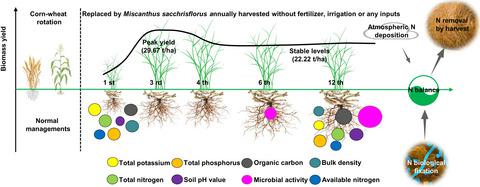当前位置:
X-MOL 学术
›
GCB Bioenergy
›
论文详情
Our official English website, www.x-mol.net, welcomes your
feedback! (Note: you will need to create a separate account there.)
Miscanthus sacchriflorus exhibits sustainable yields and ameliorates soil properties but potassium stocks without any input over a 12‐year period in China
Global Change Biology Bioenergy ( IF 5.9 ) Pub Date : 2020-07-01 , DOI: 10.1111/gcbb.12700 Chunqiao Zhao 1 , Xifeng Fan 1 , Xiaona Li 1 , Xincun Hou 1 , Weiwei Zhang 1 , Yuesen Yue 1 , Yi Zhu 1 , Chao Wang 1 , Yiling Zuo 1 , Juying Wu 1
Global Change Biology Bioenergy ( IF 5.9 ) Pub Date : 2020-07-01 , DOI: 10.1111/gcbb.12700 Chunqiao Zhao 1 , Xifeng Fan 1 , Xiaona Li 1 , Xincun Hou 1 , Weiwei Zhang 1 , Yuesen Yue 1 , Yi Zhu 1 , Chao Wang 1 , Yiling Zuo 1 , Juying Wu 1
Affiliation

|
The perennial C4 Miscanthus spp. is used in China for bio‐fuel production and its ecological functions. However, questions arise as to its economic and environmental sustainability in abandoned farmland where the costs should be very low. Little is known about its yield performance and effects on soil properties when it was harvested annually without any inputs in China. To address these questions, an experiment was implemented for 12 years on annually harvested Miscanthus sacchariflorus planted in 2006 and managed without fertilization, irrigation, or any other inputs. We determined biomass yields each year, biomass allocation, and soil properties before and after its cultivation. Biomass yields of M. sacchariflorus reached a peak value (29.67 t/ha) 3 years after cultivation and was maintained at a stable level (averaged 22.22 t/ha) during 2012–2017. Its root shoot ratio increased due to more biomass allocated below‐ground with time. Long‐term cultivation of M. sacchariflorus increased organic carbon contents, pH (for the absence of fertilization), microbial carbon, nitrogen and phosphorus contents, and soil carbon nitrogen ratios (0–100 cm). Soil bulk density was decreased significantly (p < .05) independent of soil depths. Annual harvest did not reduce total nitrogen and phosphorus, available nitrogen, and potassium, but total the potassium content of soil (0–100 cm). Cultivation of M. sacchariflorus increased available phosphorus contents in 40–100 cm soil and reduced that value in 20–40 cm soil. Biological nitrogen fixation provided ~218.74 kg ha−1 year−1 (1 m depth) nitrogen for the system offsetting nitrogen export by biomass harvest and stabilizing nitrogen levels of soil. In conclusion, M. sacchriflorus exhibited sustainable biomass yields and ameliorated soil properties but the decrease of total potassium contents after 12 years’ cultivation without any input. These conclusions could provide important information timely for the government and encourage farmers to promote large‐scale utilization of M. sacchriflorus on the abandoned farmland in China.
更新日期:2020-07-01










































 京公网安备 11010802027423号
京公网安备 11010802027423号